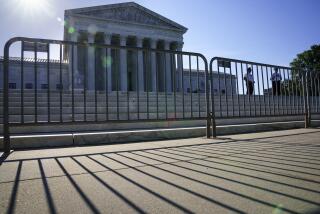Justice O’Connor Swings a Mighty Vote
- Share via
On this Independence Day, a few citizens may pause between burgers and beers to consider this country’s long struggle against the pernicious practice of one-person rule.
With the end of the Supreme Court’s term last week, it is not clear that this struggle has been nearly as successful as our holiday folklore might suggest. Even as we commemorate our rejection of one supreme leader in 1776, lawyers and politicians are studying the latest social and legal decisions mandated by another: Associate Justice Sandra Day O’Connor.
Because of her position as the perennial “swing vote” on a divided Supreme Court, O’Connor continues to dictate massive changes for the nation based on her own highly evolving views and priorities.
This term alone, O’Connor’s concurring opinions produced sweeping changes in areas ranging from drug-testing of high school students to the entanglement of church and state.
Over the years, we have come to accept a new reality: As O’Connor changes, so does the nation.
The division on the court means that we effectively have a Supreme Court of one in many areas. In a study of the 1999 term, O’Connor held the highest percentage of voting with the majority in decisions, a whopping 85% of the time. This gives her a remarkable level of power because the court often splits 5 to 4 in the most important cases, as was the case in 26 out of 85 cases in the 2000 term.
As a result, every term is preceded by commentators debating how O’Connor currently views abortion or the death penalty or federalism.
O’Connor is not alone in this pivotal role. Associate Justice Anthony Kennedy also has become a trump player in some areas. Yet, on the major social issues, it has more often been O’Connor who is positioned to dictate the outcome.
O’Connor’s swing votes have fundamentally changed rules in a host of controversial areas. Other areas linger in an uncertain status. For example, because of her past criticism of Roe vs. Wade, there is an annual O’Connor-watch to determine whether she will maintain, restrict or extinguish the right to abortion.
O’Connor has repeatedly played this role of judicial Hamlet, staring into the skull of constitutional doctrine and contemplating its sudden demise. For example, she was previously the key concurring vote to bar the government from giving money to religious schools to prevent the entanglement of church and state. This year, however, O’Connor felt more comfortable with some entanglement and exercised her trump vote to allow school vouchers and to effectively rewrite church-state doctrine.
Ultimately, however, it is perfectly legitimate for O’Connor’s views to evolve and for her to support changes advocated by other members. It is the structure of the court, and not O’Connor, that is to blame for this situation.
The cause of this problem is not what the Constitution says but what it does not say.
In establishing the Supreme Court, the framers left out an intriguing little detail: how many people would sit on the court. As a result, the number of justices has actually fluctuated through the years from a low of five members in 1801 to a high of 10 in 1863. There have been eight different configurations through the years.
Our current number is dictated only by tradition.
This tradition was challenged in 1937 by President Franklin Delano Roosevelt, who grew so exasperated with the court striking down his New Deal program that he stated an intention to increase the court to 15 members. Roosevelt never carried out this threat. He did not have to. One justice switched sides after the threat and voted in favor of some of Roosevelt’s programs, a change that became known as the “switch in time that saved nine.”
Ironically, I have long believed that Roosevelt was right for the wrong reason. Capping the court at nine justices was a terrible idea and made the current problem of one-person rule inevitable.
A better option would be to increase the size of the court to 19 members, roughly the size of a standard circuit court. This would serve to reduce the individual importance of justices and foster a greater array of perspectives on this court.
Such an expanded court could still produce close splits, but it would be less likely that a single justice would be viewed as determinative in most of these close cases.
Meanwhile, I will celebrate the Fourth with my wife and three boys with our annual flag-raising and off-key version of “God Bless America.” I will then think of the many things I love about this country and pray that in the coming term O’Connor likes them too.
More to Read
Get the L.A. Times Politics newsletter
Deeply reported insights into legislation, politics and policy from Sacramento, Washington and beyond. In your inbox twice per week.
You may occasionally receive promotional content from the Los Angeles Times.










